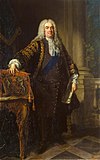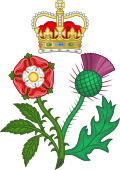
The Walpole ministry was led by Whig Prime Minister Robert Walpole, 1st Earl of Orford, from 1730 to 1742—when Walpole left the government.
Ministry
| This section needs additional citations for verification. Please help improve this article by adding citations to reliable sources in this section. Unsourced material may be challenged and removed. Find sources: "Walpole ministry" – news · newspapers · books · scholar · JSTOR (July 2009) (Learn how and when to remove this message) |
See also
- 1734 British general election
- 1741 British general election
- 1742 vote of no confidence in the Walpole ministry
Notes
- Taylor 2002

- ^ Cook & Stevenson 1988, p. 39

- ^ Cook & Stevenson 1988, p. 40
References
- Cook, Chris; Stevenson, John (1988), British Historical Facts: 1688–1760, Palgrave Macmillan UK, ISBN 978-1-349-02369-1
- Taylor, Stephen (2002), "Robert Walpole, First Earl of Orford", in Robert Eccleshall; Graham Walker (eds.), Biographical Dictionary of British Prime Ministers, Routledge, ISBN 978-1-134-66231-9
Further reading
- Langford, Paul (1998), A Polite and Commercial People: England 1727–1783, Clarendon Press, p. 56, ISBN 978-0-19-820733-7
| Preceded byWalpole–Townshend ministry | Government of Great Britain 16 May 1730 – 11 February 1742 (1730-05-16 – 1742-02-11) |
Succeeded byCarteret ministry |
| Cabinet of Prime Minister Sir Robert Walpole (1730–1742) | ||
|---|---|---|
| Southern Secretary |
|  |
| Northern Secretary |
| |
| Lord Chancellor |
| |
| Lord President of the Council |
| |
| Lord Privy Seal |
| |
| First Lord of the Admiralty |
| |
| Master-General of the Ordnance |
| |
| Paymaster of the Forces |
| |
| Lord Steward |
| |
| Lord Chamberlain |
| |
| History |
|  |
|---|---|---|
| Royal houses | ||
| Politics |
| |
| Geography | ||
| Architecture | ||
| Literature | ||
| Other | ||
| Symbols | ||
